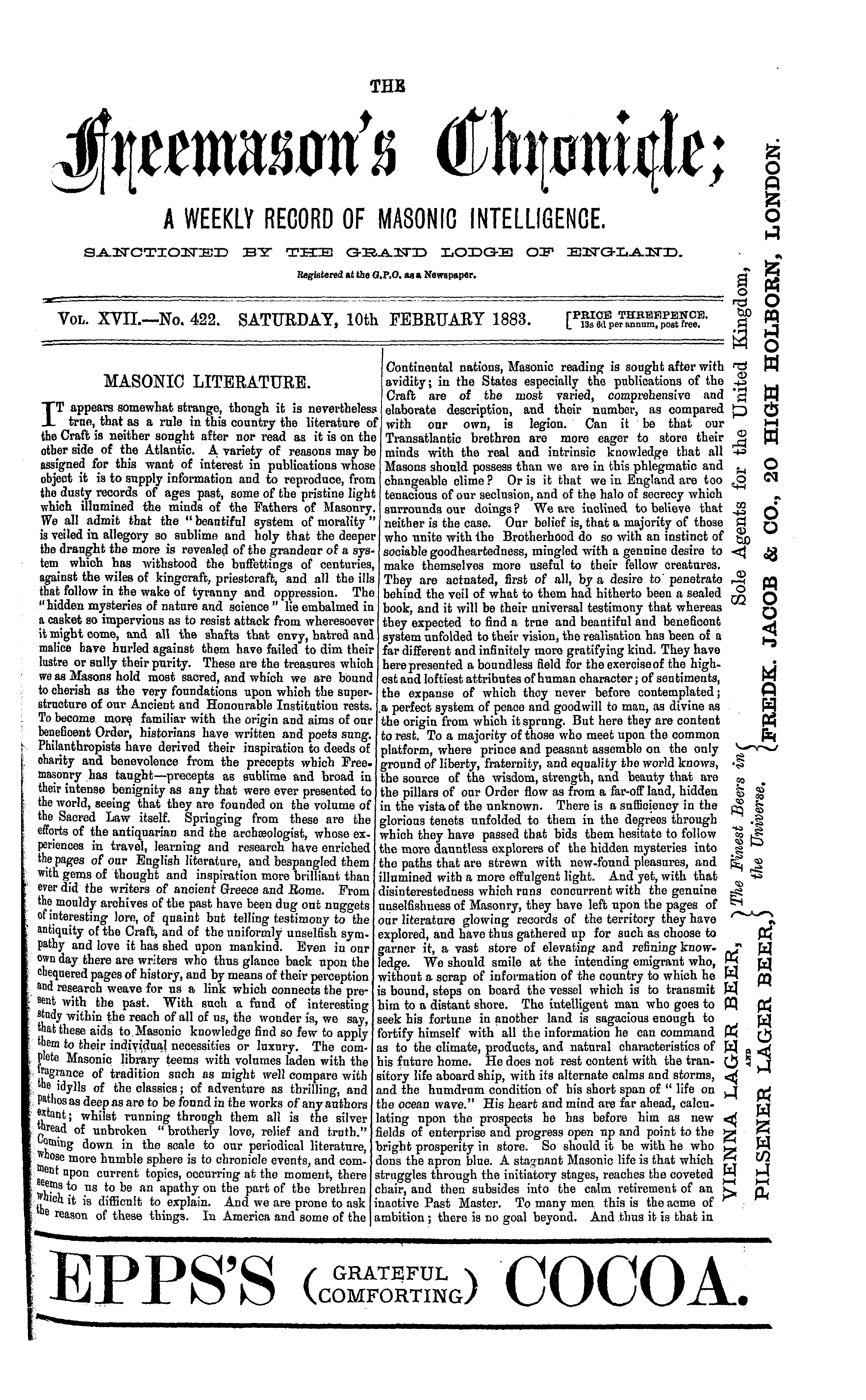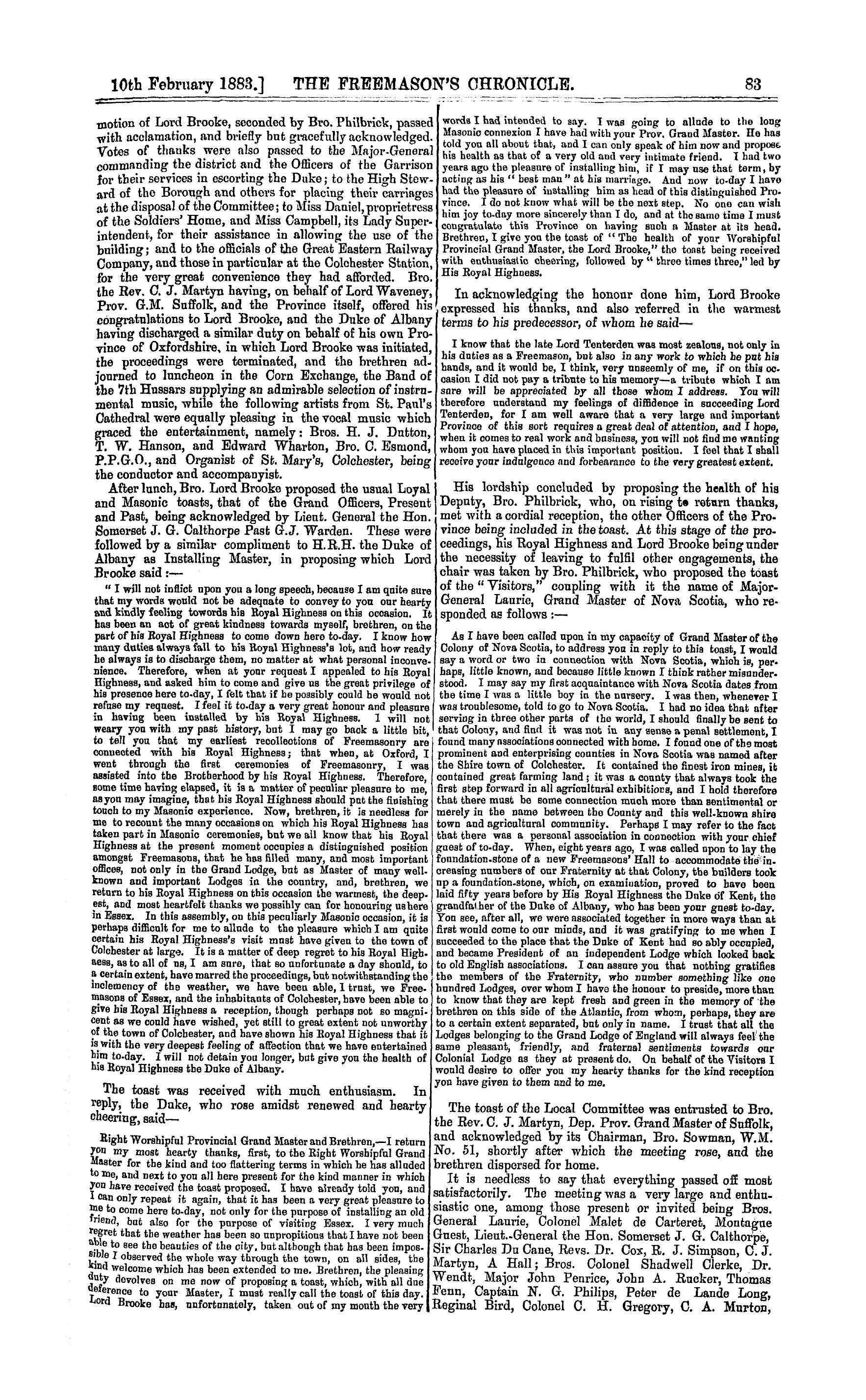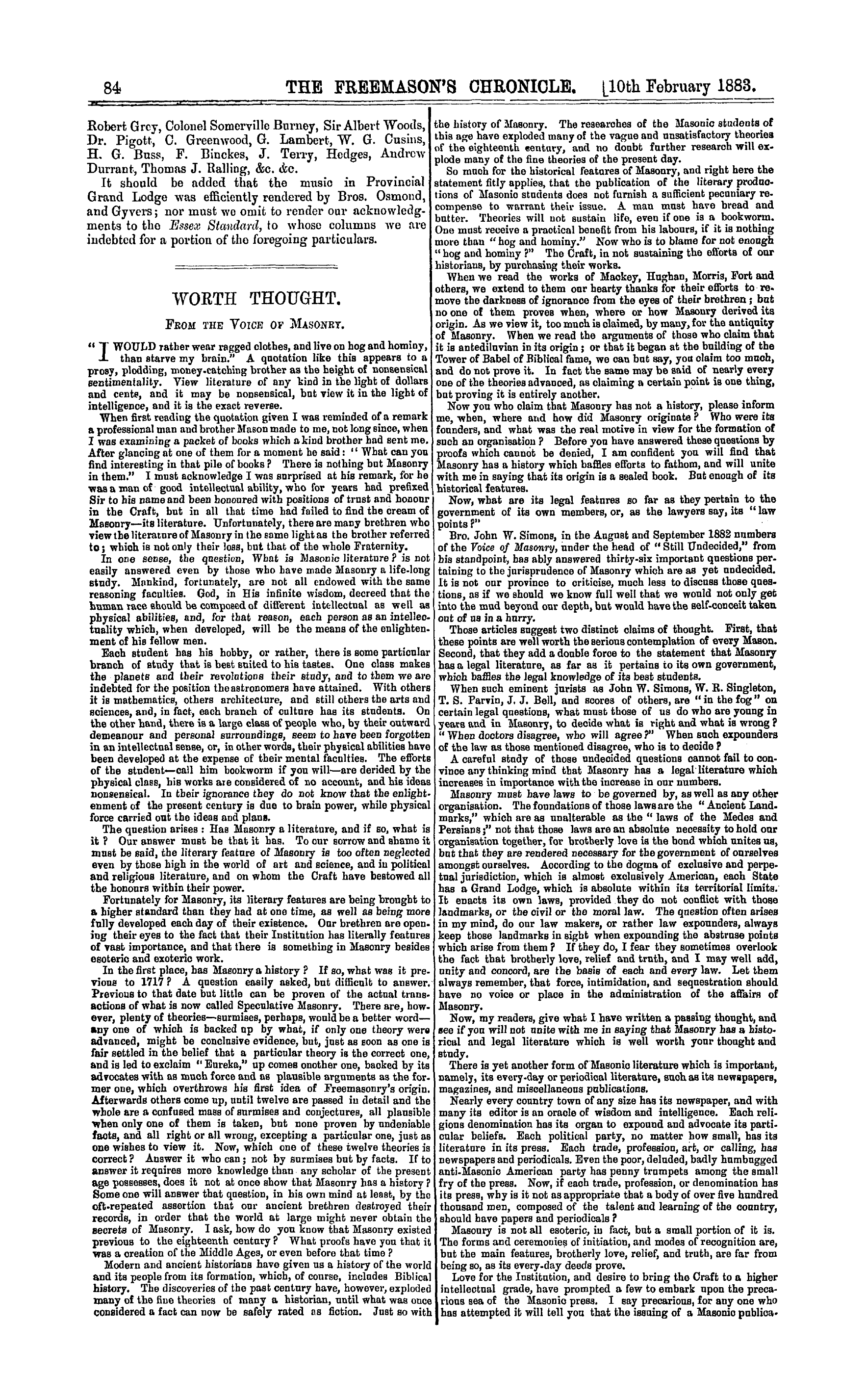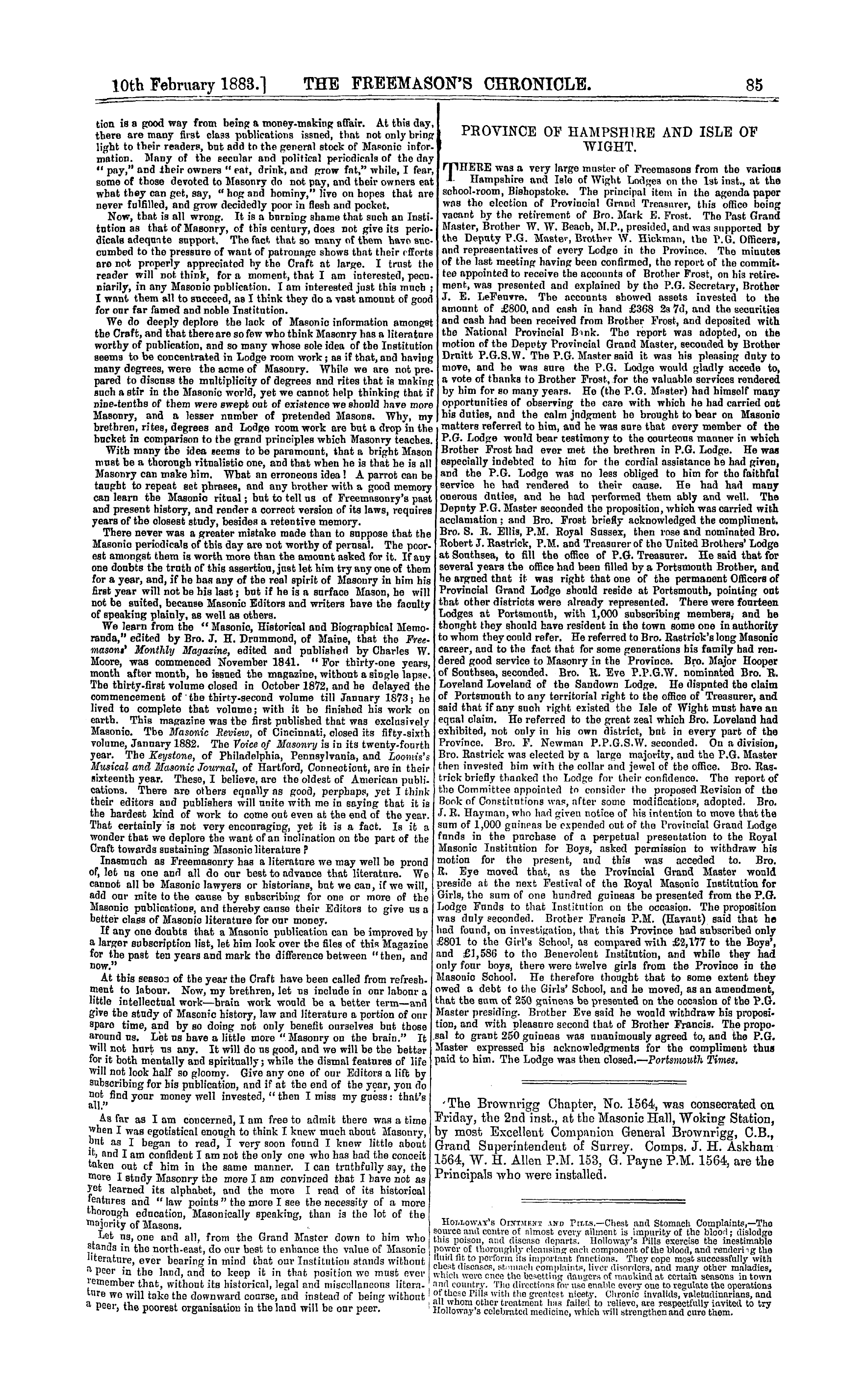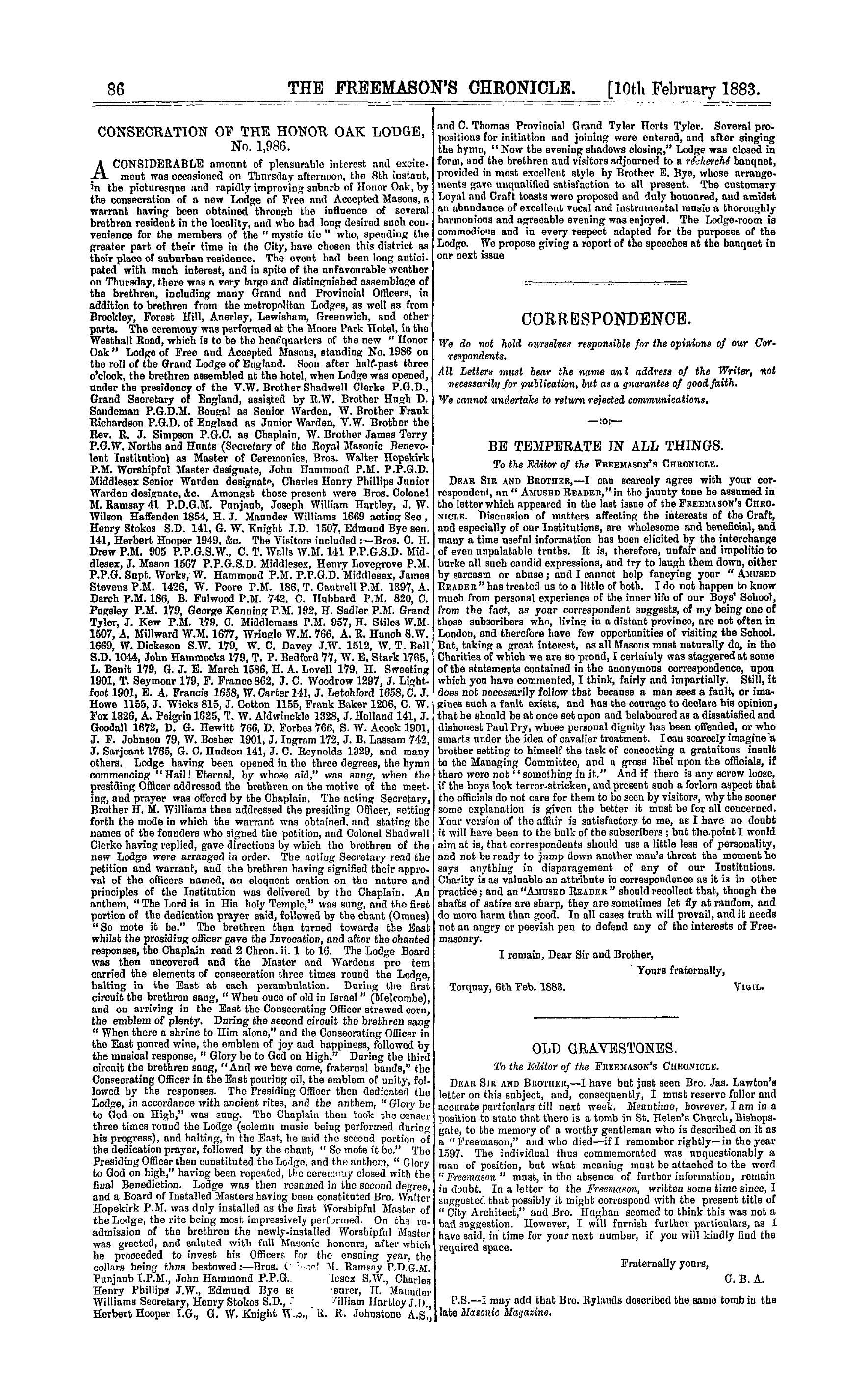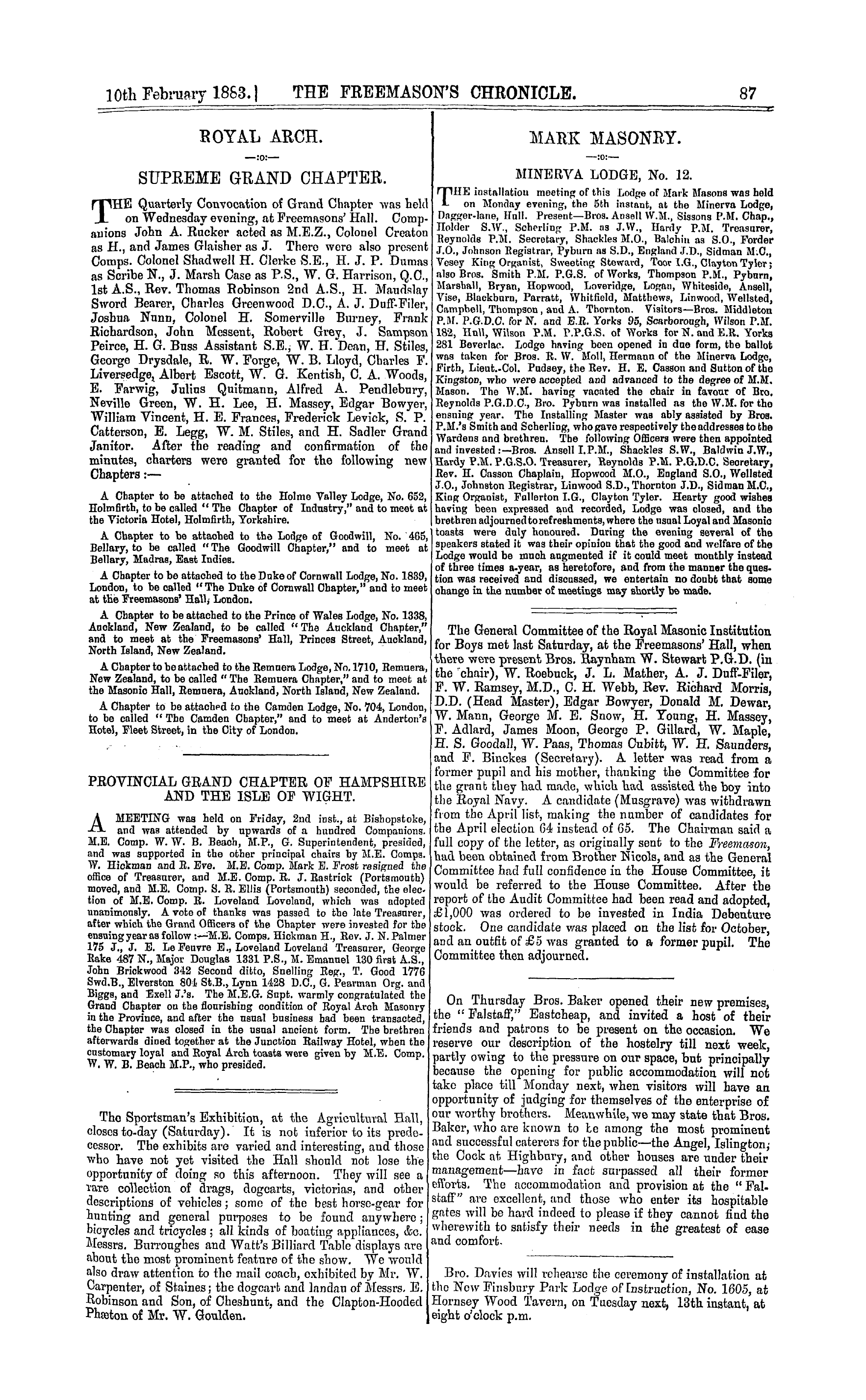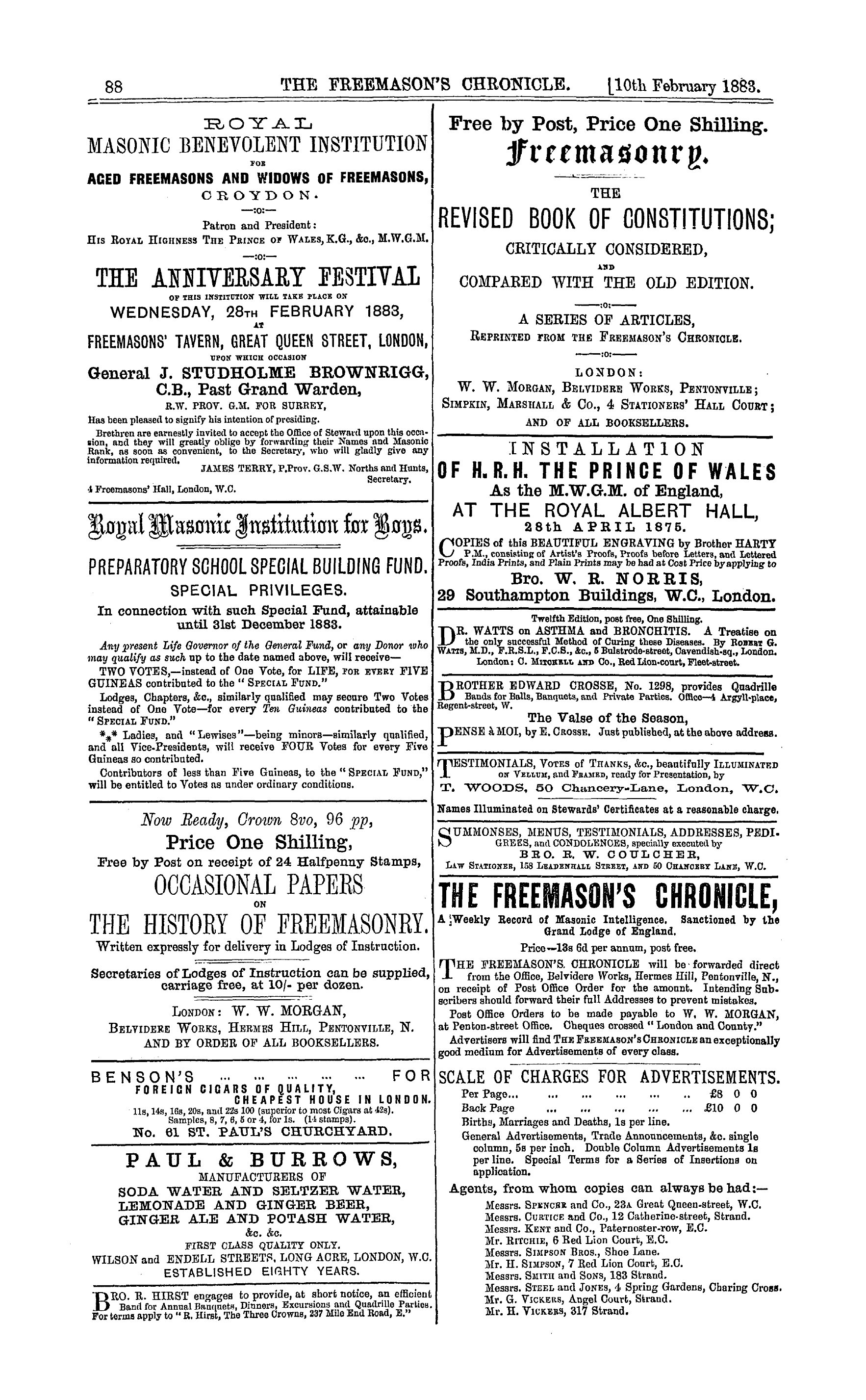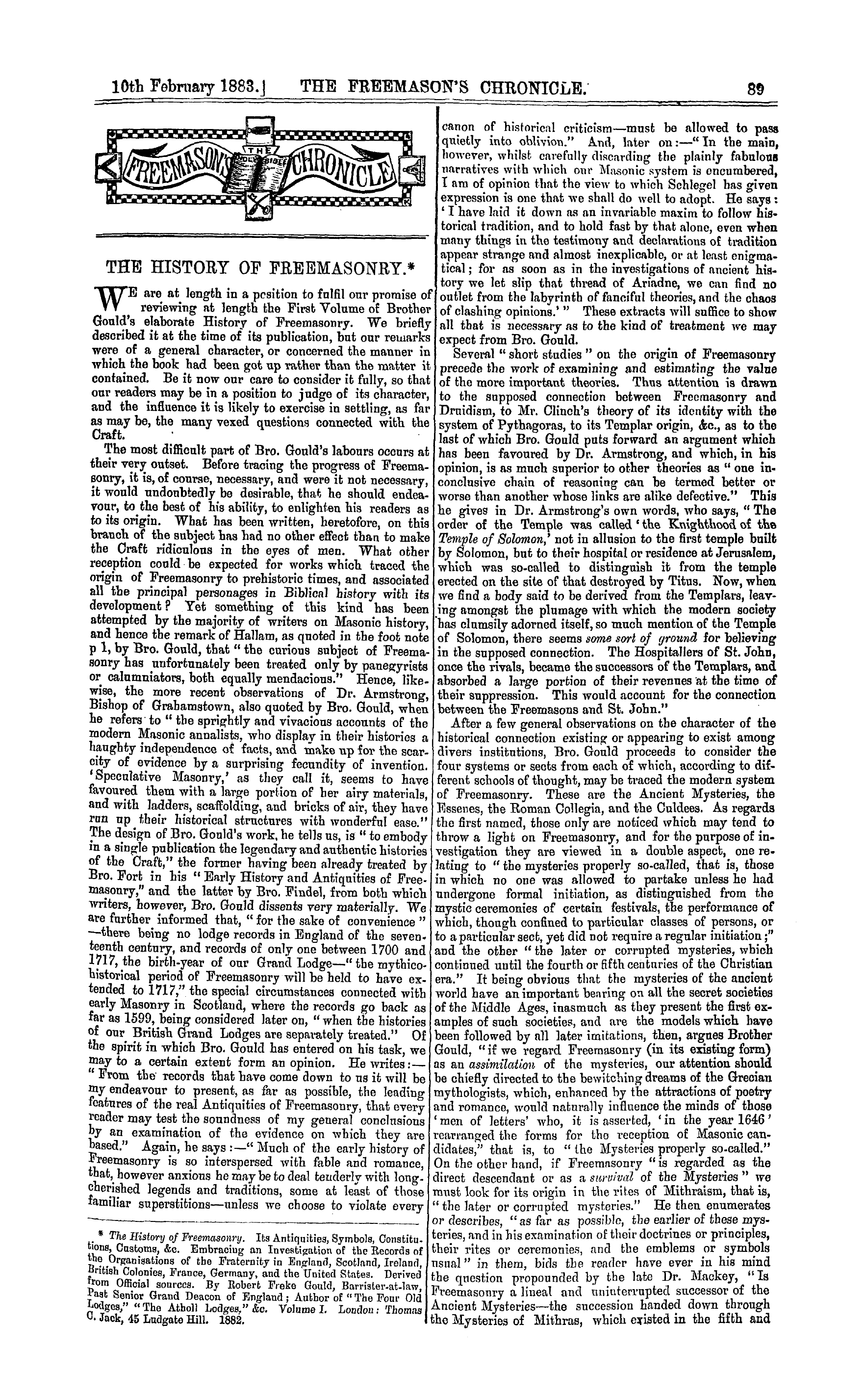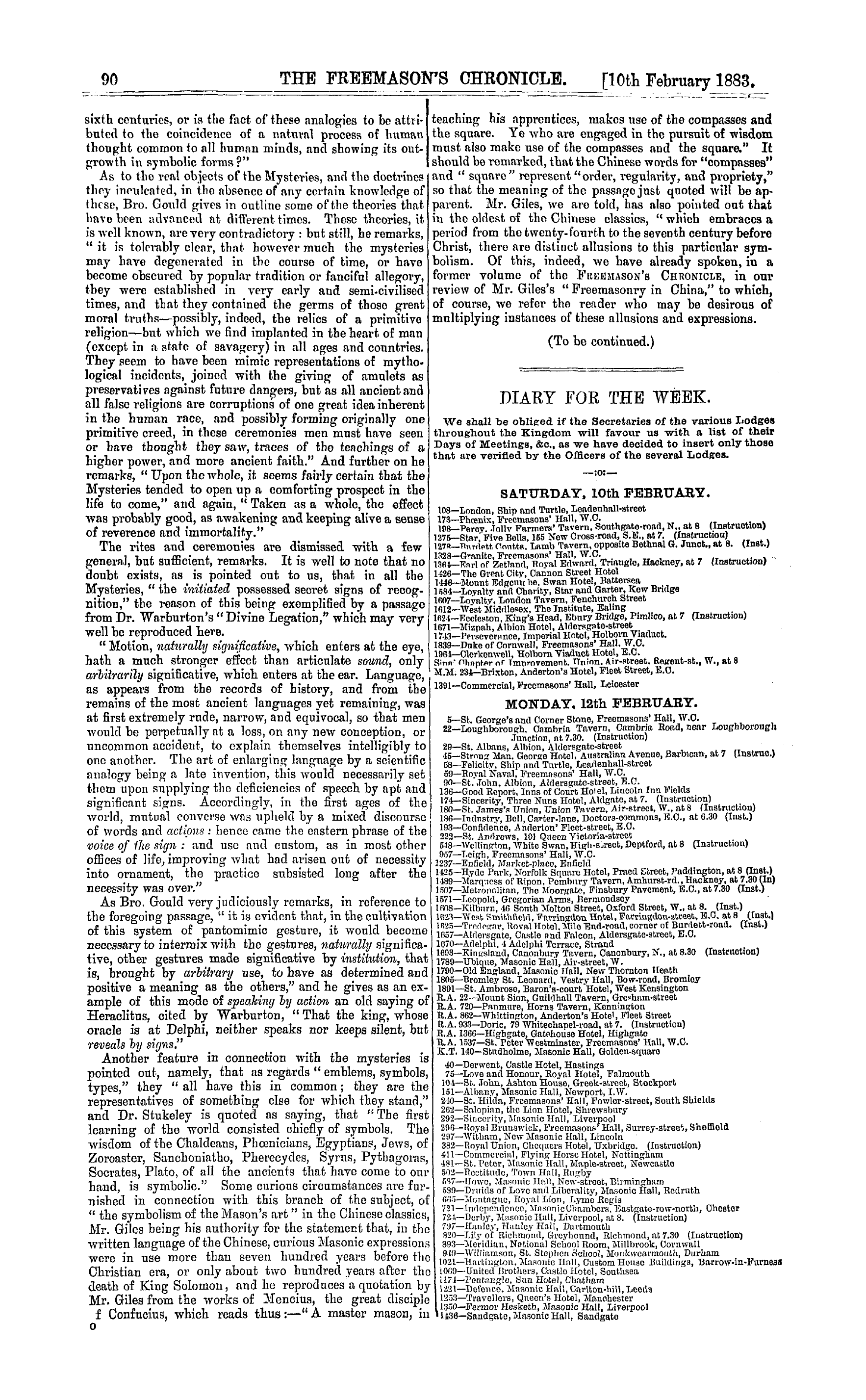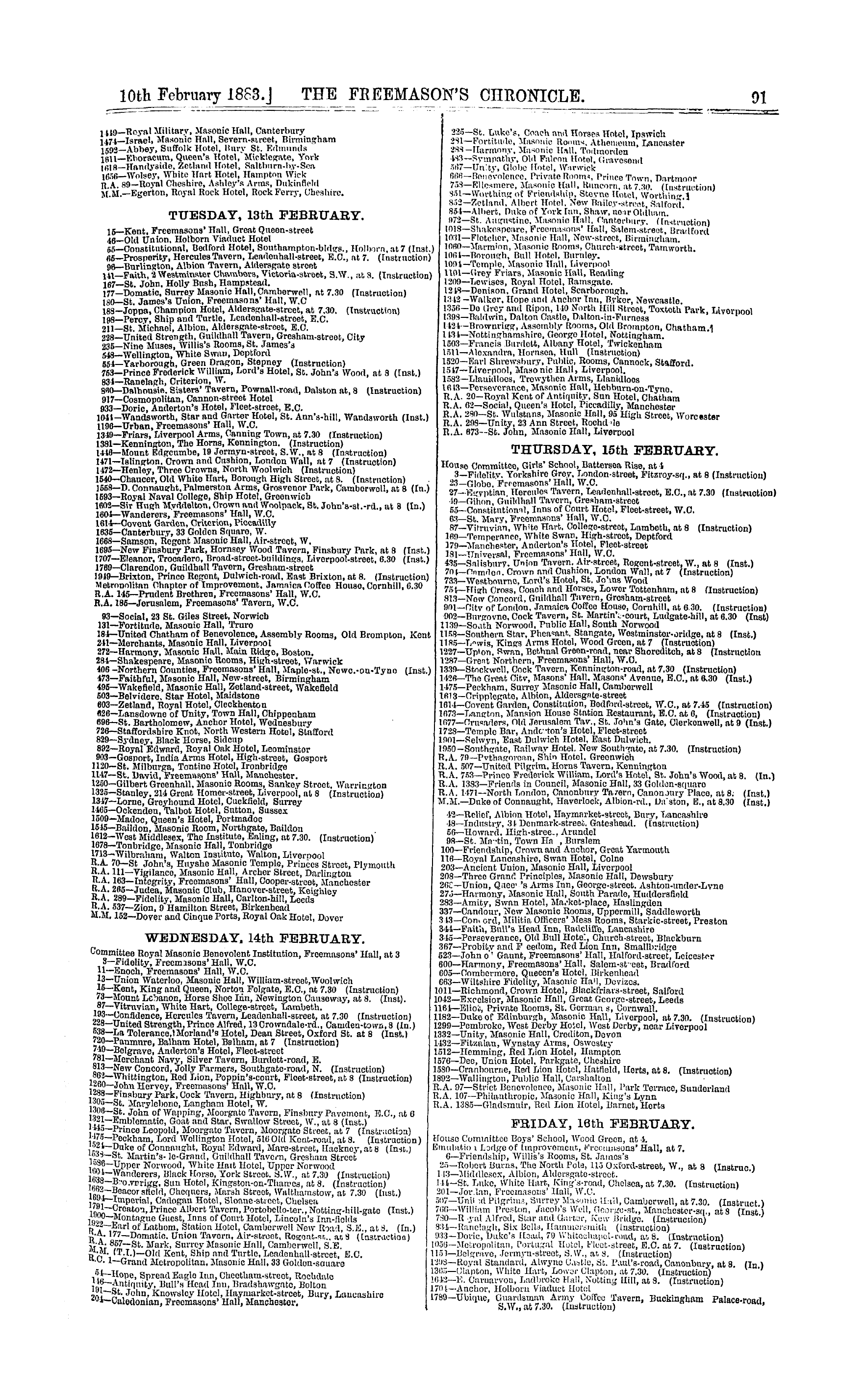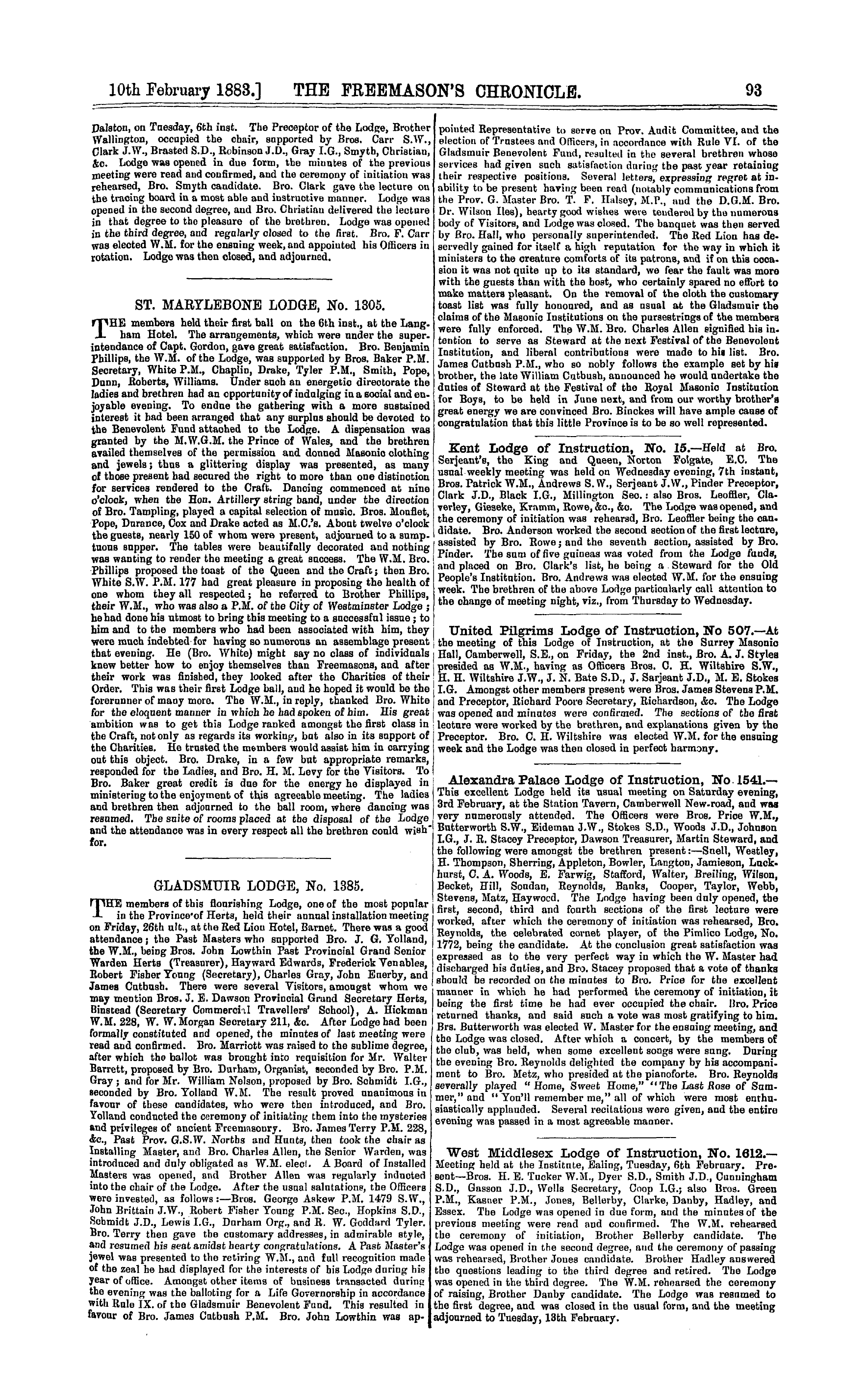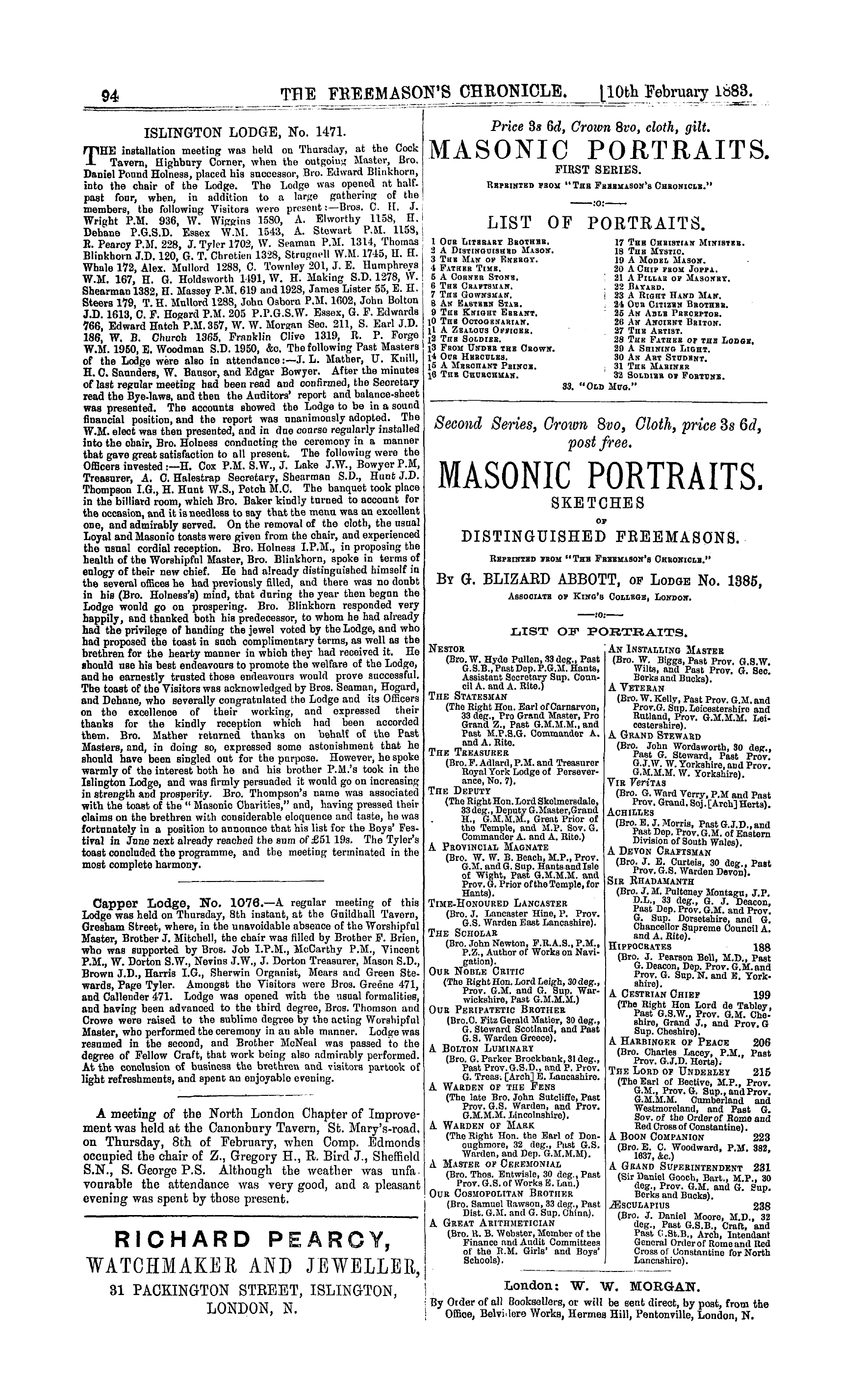-
Articles/Ads
Article Untitled Page 1 of 1 Article THE HISTORY OF FREEMASONRY.* Page 1 of 2 Article THE HISTORY OF FREEMASONRY.* Page 1 of 2 →
Note: This text has been automatically extracted via Optical Character Recognition (OCR) software.
Ar00902
The History Of Freemasonry.*
THE HISTORY OF FREEMASONRY . *
WE are at length in a position to fulfil onr promise of reviewing at length the First Volume of Brother Gould ' s elaborate History of Freemasonry . We briefly described it at the time of its publication , but our remarks were of a general character , or concerned the manner in
which the book had been got up rather than the matter it contained . Be it now our care to consider it fully , so that our readers may be in a position to judge of its character , and the influence it is likely to exercise in settling , as far as may be , the many vexed questions connected with the Craft .
The most difficult part of Bro . Gould ' s labours occurs at their very outset . Before tracing the progress of Freemasonry , it is , of course , necessary , and were it not necessary , it would undoubtedly be desirable , that he should endeavour , to the best of his ability , to enlighten his readers as
to its origin . What has been written , heretofore , on this branch of the subject has had no other effect than to make the Craft ridiculous in the eyes of men . What other reception could be expected for works which traced the origin of Freemasonry to prehistoric times , and associated
all the principal personages in Biblical history with its development ? Yet something of this kind has been attempted by the majority of writers on Masonic history , and hence the remark of Hallam , as quoted in the foot note P 1 > by Bro . Gould , that " the curious subject of
Freemasonry has unfortunately been treated only by panegyrists or calumniators , both equally mendacious . " Hence , likewise , the more recent observations of Dr . Armstrong , Bishop of Grahamstown , also quoted by Bro . Gould , when he refers to " the sprightly and vivacious accounts of the
modern Masonic annalists , who display in their histories a haughty independence of facts , and -make np for the scarcity of evidence by a surprising fecundity of invention . 'Speculative Masonry , ' as they call it , seems to have favoured them with a large portion of her airy materials ,
and with ladders , scaffolding , and bricks of air , they have ran up their historical structures with wonderful ease . " The design of Bro . Gould ' s work , he tells us , is " to embody in a single publication the legendary and authentic histories of the Craft , " the former having been already treated by Bro . Fort in his " Early History and Antiquities of Freemasonry , " and the latter by Bro . Findel , from both which writers , however , Bro . Gould dissents very materially . We are further ^ informed that , " for the sake of convenience " —there being no lodge records in England of the
seventeenth century , and records of only one between 1700 and 1717 , the birth-year of our Grand Lodge— " the mytbicohistorical period of Freemasonry will be held to have extended to 1717 , " the special circumstances connected with early Masonry in Scotland , where the records go back as
far as 1599 , being considered later on , " when the histories of our British Grand Lodges are separately treated . " Of the spirit in which Bro . Gould has entered on his task , we may to a certain extent form an opinion . He writes : — ' From the Tecords that have come down to us it will be
my endeavour to present , as far as possible , the leading features of the real Antiquities of Freemasonry , that every reader mav test the soundness of mv o-eneral nonfilnsirms
b y an examination of the evidence on which they are based . " Again , he says : — " Much of the early history of Freemasonry is so interspersed with fable and romance , that ^ however anxious he may be to deal tenderly with longcherished legends and traditions , some at least of those familiar superstitions—unless we choose to violate every
The History Of Freemasonry.*
canon of historical criticism—must be allowed to pass quietly into oblivion . " And , later on : — " In the main , however , whilst carefully discarding the plainly fabulous
narratives with which our Masonic system is encumbered , I am of opinion that the view to which Schlegel has given expression is one that we shall do well to adopt . He says ' I have laid it down as an invariable maxim to follow
historical tradition , and to hold fast by that alone , even when many things in the testimony and declarations of tradition appear strange and almost inexplicable , or at least enigmatical ; for as soon as in the investigations of ancient
history we let slip that thread of Ariadne , we can find no outlet from the labyrinth of fanciful theories , and the chaos of clashing opinions . ' " These extracts will suffice to show all that is necessary as to the kind of treatment we may expect from Bro . Gould .
Several " short studies " on the origin of Freemasonry precede the work of examining and estimating the value of the more important theories . Thus attention is drawn to the supposed connection between Freemasonry and Drnidistn , io Mr . Clinch's theory of its identity with the
system of Pythagoras , to its Templar origin , Ac , as to the last of which Bro . Gould puts forward an argument which has been favoured by Dr . Armstrong , and which , in his opinion , is as much superior to other theories as " one inconclusive chain of reasoning can be termed better or worse than another whose links are alike defective . " This
he gives in Dr . Armstrong ' s own words , who says , " The order of the Temple was called ' the Knighthood of tho Temple of Solomon , ' not in allusion to the first temple built by Solomon , but to their hospital or residence at Jerusalem , which was so-called to distinguish it from the temple
erected on the site of that destroyed by Titus . Now , when we find a body said to be derived from the Templars , leaving amongst the plumage with which the modern society has clumsily adorned itself , so much mention of the Temple of Solomon , there seems some sort of ground for believing
in the supposed connection . The Hospitallers of St . John , once the rivals , became the successors of the Templars , and absorbed a large portion of their revenues at the time of their suppression . This would account for the connection between the Freemasons and St . John . "
After a few general observations on the character of the historical connection existing or appearing to exist among divers institutions , Bro . Gould proceeds to consider the four systems or sects from each of which , according to different schools of thought , may be traced the modern system
of Freemasonry . These are the Ancient Mysteries , the Essenes , the Roman Collegia , and the Culdees . As regards the first named , those only are noticed which may tend to throw a light on Freemasonry , and for the purpose of investigation they are viewed in a double aspect , one
relating to " the mysteries properly so-called , that is , those in which no one was allowed to partake unless he had undergone formal initiation , as distinguished from the mystic ceremonies of certain festivals , the performance of
which , though confined to particular classes of persons , or to a particular sect , yet did not require a regular initiation ;" and the other " the later or corrupted mysteries , which continued nntil the fourth or fifth centuries of the Christian
era . " It being obvious that the mysteries of the ancient world have an important bearing on all the secret societies of the Middle Ages , inasmuch as they present the first examples of such societies , and are the models which have been followed by all later imitations , then , argues Brother
Gould , " if we regard Freemasonry ( in its existing form ) as an assimilation of the mysteries , our attention should be chiefly directed to the bewitching dreams of the Grecian mythologists , which , enhanced by the attractions of poetry and romance , would naturally influence the minds of those
'men of letters' who , it is asserted , 'in the year 1646 ' rearranged the forms for tho reception of Masonic candidates , " that is , to " the Mysteries properly so-called . " On the other hand , if Freemasonry "is regarded as the direct descendant or as a survival of the Mysteries " we
must look for its origin in the rites of Mithraism , that is , " the later or corrupted mysteries . " He then enumerates or describes , " as far as possible , the earlier of these mysteries , and in his examination of their doctrines or principles , their rites or ceremonies , and the emblems or symbols
usual" in them , bids tbe reader have ever m his mmd the question propounded by the late Dr . Mackey , "Is Freemasonry a lineal and uninterrupted successor of the Ancient Mysteries—the succession handed down through the Mysteries of Mithras , which existed in the fifth and
Note: This text has been automatically extracted via Optical Character Recognition (OCR) software.
Ar00902
The History Of Freemasonry.*
THE HISTORY OF FREEMASONRY . *
WE are at length in a position to fulfil onr promise of reviewing at length the First Volume of Brother Gould ' s elaborate History of Freemasonry . We briefly described it at the time of its publication , but our remarks were of a general character , or concerned the manner in
which the book had been got up rather than the matter it contained . Be it now our care to consider it fully , so that our readers may be in a position to judge of its character , and the influence it is likely to exercise in settling , as far as may be , the many vexed questions connected with the Craft .
The most difficult part of Bro . Gould ' s labours occurs at their very outset . Before tracing the progress of Freemasonry , it is , of course , necessary , and were it not necessary , it would undoubtedly be desirable , that he should endeavour , to the best of his ability , to enlighten his readers as
to its origin . What has been written , heretofore , on this branch of the subject has had no other effect than to make the Craft ridiculous in the eyes of men . What other reception could be expected for works which traced the origin of Freemasonry to prehistoric times , and associated
all the principal personages in Biblical history with its development ? Yet something of this kind has been attempted by the majority of writers on Masonic history , and hence the remark of Hallam , as quoted in the foot note P 1 > by Bro . Gould , that " the curious subject of
Freemasonry has unfortunately been treated only by panegyrists or calumniators , both equally mendacious . " Hence , likewise , the more recent observations of Dr . Armstrong , Bishop of Grahamstown , also quoted by Bro . Gould , when he refers to " the sprightly and vivacious accounts of the
modern Masonic annalists , who display in their histories a haughty independence of facts , and -make np for the scarcity of evidence by a surprising fecundity of invention . 'Speculative Masonry , ' as they call it , seems to have favoured them with a large portion of her airy materials ,
and with ladders , scaffolding , and bricks of air , they have ran up their historical structures with wonderful ease . " The design of Bro . Gould ' s work , he tells us , is " to embody in a single publication the legendary and authentic histories of the Craft , " the former having been already treated by Bro . Fort in his " Early History and Antiquities of Freemasonry , " and the latter by Bro . Findel , from both which writers , however , Bro . Gould dissents very materially . We are further ^ informed that , " for the sake of convenience " —there being no lodge records in England of the
seventeenth century , and records of only one between 1700 and 1717 , the birth-year of our Grand Lodge— " the mytbicohistorical period of Freemasonry will be held to have extended to 1717 , " the special circumstances connected with early Masonry in Scotland , where the records go back as
far as 1599 , being considered later on , " when the histories of our British Grand Lodges are separately treated . " Of the spirit in which Bro . Gould has entered on his task , we may to a certain extent form an opinion . He writes : — ' From the Tecords that have come down to us it will be
my endeavour to present , as far as possible , the leading features of the real Antiquities of Freemasonry , that every reader mav test the soundness of mv o-eneral nonfilnsirms
b y an examination of the evidence on which they are based . " Again , he says : — " Much of the early history of Freemasonry is so interspersed with fable and romance , that ^ however anxious he may be to deal tenderly with longcherished legends and traditions , some at least of those familiar superstitions—unless we choose to violate every
The History Of Freemasonry.*
canon of historical criticism—must be allowed to pass quietly into oblivion . " And , later on : — " In the main , however , whilst carefully discarding the plainly fabulous
narratives with which our Masonic system is encumbered , I am of opinion that the view to which Schlegel has given expression is one that we shall do well to adopt . He says ' I have laid it down as an invariable maxim to follow
historical tradition , and to hold fast by that alone , even when many things in the testimony and declarations of tradition appear strange and almost inexplicable , or at least enigmatical ; for as soon as in the investigations of ancient
history we let slip that thread of Ariadne , we can find no outlet from the labyrinth of fanciful theories , and the chaos of clashing opinions . ' " These extracts will suffice to show all that is necessary as to the kind of treatment we may expect from Bro . Gould .
Several " short studies " on the origin of Freemasonry precede the work of examining and estimating the value of the more important theories . Thus attention is drawn to the supposed connection between Freemasonry and Drnidistn , io Mr . Clinch's theory of its identity with the
system of Pythagoras , to its Templar origin , Ac , as to the last of which Bro . Gould puts forward an argument which has been favoured by Dr . Armstrong , and which , in his opinion , is as much superior to other theories as " one inconclusive chain of reasoning can be termed better or worse than another whose links are alike defective . " This
he gives in Dr . Armstrong ' s own words , who says , " The order of the Temple was called ' the Knighthood of tho Temple of Solomon , ' not in allusion to the first temple built by Solomon , but to their hospital or residence at Jerusalem , which was so-called to distinguish it from the temple
erected on the site of that destroyed by Titus . Now , when we find a body said to be derived from the Templars , leaving amongst the plumage with which the modern society has clumsily adorned itself , so much mention of the Temple of Solomon , there seems some sort of ground for believing
in the supposed connection . The Hospitallers of St . John , once the rivals , became the successors of the Templars , and absorbed a large portion of their revenues at the time of their suppression . This would account for the connection between the Freemasons and St . John . "
After a few general observations on the character of the historical connection existing or appearing to exist among divers institutions , Bro . Gould proceeds to consider the four systems or sects from each of which , according to different schools of thought , may be traced the modern system
of Freemasonry . These are the Ancient Mysteries , the Essenes , the Roman Collegia , and the Culdees . As regards the first named , those only are noticed which may tend to throw a light on Freemasonry , and for the purpose of investigation they are viewed in a double aspect , one
relating to " the mysteries properly so-called , that is , those in which no one was allowed to partake unless he had undergone formal initiation , as distinguished from the mystic ceremonies of certain festivals , the performance of
which , though confined to particular classes of persons , or to a particular sect , yet did not require a regular initiation ;" and the other " the later or corrupted mysteries , which continued nntil the fourth or fifth centuries of the Christian
era . " It being obvious that the mysteries of the ancient world have an important bearing on all the secret societies of the Middle Ages , inasmuch as they present the first examples of such societies , and are the models which have been followed by all later imitations , then , argues Brother
Gould , " if we regard Freemasonry ( in its existing form ) as an assimilation of the mysteries , our attention should be chiefly directed to the bewitching dreams of the Grecian mythologists , which , enhanced by the attractions of poetry and romance , would naturally influence the minds of those
'men of letters' who , it is asserted , 'in the year 1646 ' rearranged the forms for tho reception of Masonic candidates , " that is , to " the Mysteries properly so-called . " On the other hand , if Freemasonry "is regarded as the direct descendant or as a survival of the Mysteries " we
must look for its origin in the rites of Mithraism , that is , " the later or corrupted mysteries . " He then enumerates or describes , " as far as possible , the earlier of these mysteries , and in his examination of their doctrines or principles , their rites or ceremonies , and the emblems or symbols
usual" in them , bids tbe reader have ever m his mmd the question propounded by the late Dr . Mackey , "Is Freemasonry a lineal and uninterrupted successor of the Ancient Mysteries—the succession handed down through the Mysteries of Mithras , which existed in the fifth and
